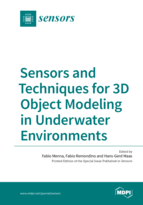Sensors and Techniques for 3D Object Modeling in Underwater Environments
A special issue of Sensors (ISSN 1424-8220).
Deadline for manuscript submissions: closed (31 October 2015) | Viewed by 128817
Special Issue Editors
Interests: underwater photogrammetry; bundle adjustment mobile mapping; optical metrology; SLAM; geodetic surveying; 3D mapping
Special Issues, Collections and Topics in MDPI journals
Interests: photogrammetry; laser scanning; optical metrology; 3D; AI; quality control
Special Issues, Collections and Topics in MDPI journals
Special Issue Information
Dear Colleagues,
Water covers approximately 71% of the planet’s surface and human activities have been relying on it since remote times. Many traces of these exist under the “zero level” and will continue to exist in the future. Measuring, positioning, and mapping objects under water have experienced very significant modifications, brought about by advances in technology and also by changed requirements, demands for new products, introduction of new tools, and the modification of existing equipment. The exploration, documentation, and recording of underwater environments remains a difficult task, and is sometimes still unsolved. The research, design, and development of techniques and procedures for correctly validating underwater environments are more than ever important.
This Special Issue originates from the ISPRS/CIPA Workshop "UNDERWATER 3D RECORDING & MODELING—Experiences in Data Acquisition, Calibration, Orientation, Modelling & Accuracy Assessment” (http://3dom.fbk.eu/files/underwater/index.html) and will accept improved and extended selected papers derived from the workshop’s proceedings, as well as new contributions from international colleagues.
We invite you to submit articles on the following topics:
- Underwater/Multi-media photogrammetry
- Underwater platforms (ROV, AUV, robot, etc.)
- Characterization of underwater passive and active sensors
- Underwater navigation and positioning
- Underwater metrology and inspections
- Geometric modeling in multi-media photogrammetry
- Accuracy requirement and assessment in underwater 3D applications
- Restoration, enhancement and processing of underwater images
- 3D bathymetry techniques
- Data processing and underwater 3D modeling
- Sensors for marine biology and water pollution
- Multi-sensor integration
Dr. Fabio Menna
Prof. Dr. Fabio Remondino
Prof. Dr. Hans-Gerd Maas
Guest Editors
Manuscript Submission Information
Manuscripts should be submitted online at www.mdpi.com by registering and logging in to this website. Once you are registered, click here to go to the submission form. Manuscripts can be submitted until the deadline. All submissions that pass pre-check are peer-reviewed. Accepted papers will be published continuously in the journal (as soon as accepted) and will be listed together on the special issue website. Research articles, review articles as well as short communications are invited. For planned papers, a title and short abstract (about 100 words) can be sent to the Editorial Office for announcement on this website.
Submitted manuscripts should not have been published previously, nor be under consideration for publication elsewhere (except conference proceedings papers). All manuscripts are thoroughly refereed through a single-blind peer-review process. A guide for authors and other relevant information for submission of manuscripts is available on the Instructions for Authors page. Sensors is an international peer-reviewed open access semimonthly journal published by MDPI.
Please visit the Instructions for Authors page before submitting a manuscript. The Article Processing Charge (APC) for publication in this open access journal is 2600 CHF (Swiss Francs). Submitted papers should be well formatted and use good English. Authors may use MDPI's English editing service prior to publication or during author revisions.
Keywords
- Underwater
- Photogrammetry
- Bathymetry
- ROV
- 3D modelling
- Multi-media
- Marine biology









